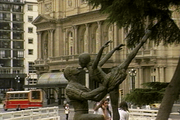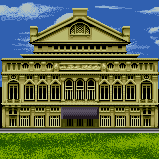Teatro Colon: Difference between revisions
From the Super Mario Wiki, the Mario encyclopedia
Jump to navigationJump to search
Son of Suns (talk | contribs) mNo edit summary |
Derekblue1 (talk | contribs) No edit summary |
||
| (17 intermediate revisions by 10 users not shown) | |||
| Line 1: | Line 1: | ||
{{multiple image | |||
The ''' | |align=right | ||
|direction=vertical | |||
|width=180 | |||
|footer=Teatro Colon in DOS, ''CD-ROM Deluxe'' and SNES versions. | |||
|image1=Teatro Colon MIMDOS.png | |||
|alt1=DOS | |||
|image2=Teatro Colon MIMCD.png | |||
|alt2=''CD-ROM Deluxe'' | |||
|image3=TeatroColon MIM.png | |||
|alt3=SNES | |||
}} | |||
{{quote|The Teatro Colon is considered one of the world's most beautiful opera houses. It is also famous for its wonderful acoustics, or sound system. It was built in 1908. The stage can hold six hundred performers and is longer than one city block! The theater is very fancy, with its huge chandeliers, red and gold box seats, and soft red upholstery. Besides opera, the Colon is home to the National Ballet and National Symphony companies.|'''Pamphlet'''|Mario is Missing! (PC)}} | |||
The '''{{wp|Teatro Colón}}''' is a famous opera house located in [[Buenos Aires]], Argentina. It appears as a landmark in the [[Mario is Missing! (PC)|PC]], [[Mario is Missing! (Super Nintendo Entertainment System)|SNES]], and [[Mario is Missing! (Nintendo Entertainment System)|NES versions of ''Mario is Missing!'']], where it is spelt without a diacritic. In the game, [[Koopa Troopa]]s steal one [[Flute from the Teatro Colon|flute]] from the building, forcing it to shut down until [[Luigi]] tracks down the flute and returns it. | |||
== Questions == | |||
Before the [[curator]] will give Luigi the posted 1,710-[[bill|dollar]] reward, he must prove the flute's authenticity by answering two of the following trivia questions: | |||
*''Which group does not perform at the Colon?'' | |||
**'''Tango dancers''' | |||
**Ballet troupe | |||
**Opera company | |||
*''When was the Teatro Colon built?'' | |||
**'''1908''' | |||
**1926 | |||
**600 | |||
* ''How many people can fit on the stage of the Teatro Colon?'' | |||
** 1908 | |||
** A city block's full | |||
** '''600''' | |||
==Names in other languages== | |||
{{foreign names | |||
|Ger=Das Teatro Colon | |||
|GerC=<ref>{{cite|publisher=[[Software Toolworks]]|title=''Mario wir vermisst''|language=German|accessdate=October 23, 2024}}</ref> | |||
}} | |||
== References == | |||
<references/> | |||
{{Earth}} | {{Earth}} | ||
{{MIM}} | |||
[[Category:Buildings]] | [[Category:Buildings]] | ||
[[Category:Mario is Missing! landmarks]] | |||
Latest revision as of 08:20, October 23, 2024
- “The Teatro Colon is considered one of the world's most beautiful opera houses. It is also famous for its wonderful acoustics, or sound system. It was built in 1908. The stage can hold six hundred performers and is longer than one city block! The theater is very fancy, with its huge chandeliers, red and gold box seats, and soft red upholstery. Besides opera, the Colon is home to the National Ballet and National Symphony companies.”
- —Pamphlet, Mario is Missing! (PC)
The Teatro Colón is a famous opera house located in Buenos Aires, Argentina. It appears as a landmark in the PC, SNES, and NES versions of Mario is Missing!, where it is spelt without a diacritic. In the game, Koopa Troopas steal one flute from the building, forcing it to shut down until Luigi tracks down the flute and returns it.
Questions[edit]
Before the curator will give Luigi the posted 1,710-dollar reward, he must prove the flute's authenticity by answering two of the following trivia questions:
- Which group does not perform at the Colon?
- Tango dancers
- Ballet troupe
- Opera company
- When was the Teatro Colon built?
- 1908
- 1926
- 600
- How many people can fit on the stage of the Teatro Colon?
- 1908
- A city block's full
- 600
Names in other languages[edit]
| Language | Name | Meaning | Notes |
|---|---|---|---|
| German | Das Teatro Colon[1] | - |
References[edit]
- ^ Mario wir vermisst. Software Toolworks (German). Retrieved October 23, 2024.


